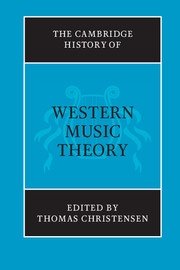Book contents
- Frontmatter
- Introduction
- PART I DISCIPLINING MUSIC THEORY
- PART II SPECULATIVE TRADITIONS
- PART III REGULATIVE TRADITIONS
- A Mapping tonal spaces
- B Compositional Theory
- 15 Organum – discantus – contrapunctus in the Middle Ages
- 16 Counterpoint pedagogy in the Renaissance
- 17 Performance theory
- 18 Steps to Parnassus: contrapuntal theory in 1725 precursors and successors
- 19 Twelve-tone theory
- C Time
- D Tonality
- PART IV DESCRIPTIVE TRADITIONS
- Index of authors
- Index of subjects
- References
16 - Counterpoint pedagogy in the Renaissance
from B - Compositional Theory
Published online by Cambridge University Press: 28 March 2008
- Frontmatter
- Introduction
- PART I DISCIPLINING MUSIC THEORY
- PART II SPECULATIVE TRADITIONS
- PART III REGULATIVE TRADITIONS
- A Mapping tonal spaces
- B Compositional Theory
- 15 Organum – discantus – contrapunctus in the Middle Ages
- 16 Counterpoint pedagogy in the Renaissance
- 17 Performance theory
- 18 Steps to Parnassus: contrapuntal theory in 1725 precursors and successors
- 19 Twelve-tone theory
- C Time
- D Tonality
- PART IV DESCRIPTIVE TRADITIONS
- Index of authors
- Index of subjects
- References
Summary
How did Renaissance composers learn their craft? They could have learned much of their technique from treatises, especially from those portions devoted to counterpoint. Today, we often think of counterpoint as consisting primarily of rules of voice leading. Such rules, which are found in virtually every music treatise of the time, teach the student to regulate the melodic motions of lines in relation to the simultaneous intervals between them (e.g., conditions for approaching perfect consonances or for preparing and resolving dissonances). They were learned by young singers for the purpose of improvisation, and following them would have been as natural as speaking in grammatically correct sentences. Yet just as the art of oratory consists of more than correct grammar, so musical composition goes far beyond mere voice leading. Composers had to choose between many large-scale contrapuntal techniques involving texture, motivic and structural repetition, and variation. While there has been extensive study by scholars of the rules of voice leading in Renaissance music, less consideration has been given to these more advanced compositional techniques.
In this chapter, then, we will examine some of these compositional techniques by reviewing some two dozen treatises written between the mid-fifteenth and mid-seventeenth centuries. We will see that the real challenge for a Renaissance composer consisted not of employing “correct” contrapuntal voice leading but rather of elaborating primary musical material – sometimes called a soggetto – by varying it or combining it with some other melodic material. (As we will see, a soggetto need not be simply a melodic subject in equal or mixed rhythmic values; it could also be a duo, or, in the case of parody technique, even an entire polyphonic composition.)
- Type
- Chapter
- Information
- The Cambridge History of Western Music Theory , pp. 503 - 533Publisher: Cambridge University PressPrint publication year: 2002
References
- 11
- Cited by



